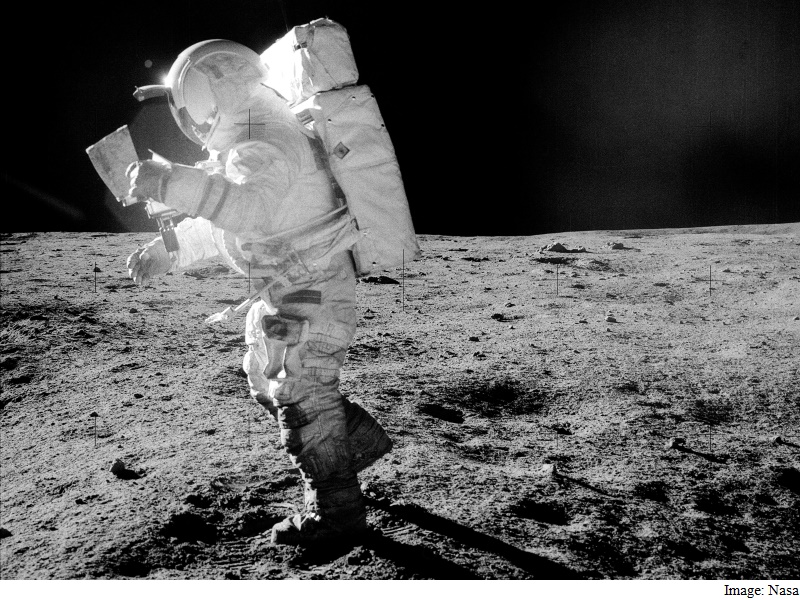- Home
- Science
- Science News
- A New, Water Logged History of the Moon
A New, Water-Logged History of the Moon

After the Apollo missions scooped up rocks from the Moon's surface and brought them home, scientists were convinced for decades that they had proof our nearest celestial neighbour was drier than a bone.
How wrong they were.
New technology detected water in those dusty samples nearly a decade ago, and a new study, published Wednesday, tells us how and when that water - lots and lots of it - likely wound up on the Moon.
In a word, asteroids.
After the Moon was born of a collision between Earth and a Mars-sized planet some 4.5 billion years ago, it was bombarded with water-rich asteroids known as carbonaceous chondrites for tens of millions of years, perhaps longer.
So was Earth, which is one reason the findings, published in Nature Communications, are of more than academic interest.
"The Moon can be viewed as a giant time capsule, preserving a record of the impact history of Earth and Moon since their formation," explained lead author Jessica Barnes, a researcher at The Open University in southern England.
On our on planet, that record has been largely erased by tectonic plates moving continents like pieces on a board game.
Giant ball of magma
Even if scientists today are sure there is water trapped on the Moon, they do not know how much, said co-author Roman Tartese, a researcher at the Minerology Institute of France's National Museum for Natural History.
"If we extrapolate from the Apollo samples, the lunar interior could contain on the order of 1,000 trillion tonnes," he told AFP.
If there is that much, it will likely be locked inside minerals in the form of hydroxyl (OH) molecules, he added.
On the surface, up to a billion tonnes of frozen water - enough to fill a million Olympic pools - is probably lodged inside deep craters around the north and south lunar poles, where the Sun's rays never penetrate.
Recent research concluded that it "has been trapped there for three or four billion years," Tartese said by email.
Water on the Moon could have very practical implications.
If future scientific missions can extract oxygen from these molecules, astronauts could live - and breath - inside bases on the lunar surface.
And the hydrogen, once separated from the oxygen, could be used as fuel for rockets or space-based mining operations.
"This may seem like science fiction," Tartese said.
"But it is one of the reasons several space agencies - including the European Space Agency and Nasa - are currently developing robotic missions to explore new regions to better estimate the quantity of ice."
It is also possible, the researchers said, that some of the water on the lunar surface may have been ejected by volcanic eruptions, bubbling up from what was once a molten interior.
The Moon, in fact, probably began as "an enormous ball of magma" progressively cooled and hardened, said Tartese.
For the latest tech news and reviews, follow Gadgets 360 on X, Facebook, WhatsApp, Threads and Google News. For the latest videos on gadgets and tech, subscribe to our YouTube channel. If you want to know everything about top influencers, follow our in-house Who'sThat360 on Instagram and YouTube.
Related Stories
- Samsung Galaxy Unpacked 2025
- ChatGPT
- Redmi Note 14 Pro+
- iPhone 16
- Apple Vision Pro
- Oneplus 12
- OnePlus Nord CE 3 Lite 5G
- iPhone 13
- Xiaomi 14 Pro
- Oppo Find N3
- Tecno Spark Go (2023)
- Realme V30
- Best Phones Under 25000
- Samsung Galaxy S24 Series
- Cryptocurrency
- iQoo 12
- Samsung Galaxy S24 Ultra
- Giottus
- Samsung Galaxy Z Flip 5
- Apple 'Scary Fast'
- Housefull 5
- GoPro Hero 12 Black Review
- Invincible Season 2
- JioGlass
- HD Ready TV
- Laptop Under 50000
- Smartwatch Under 10000
- Latest Mobile Phones
- Compare Phones
- Infinix Smart 9 HD
- Lava Yuva Smart
- Samsung Galaxy S25 Ultra
- Samsung Galaxy S25+
- Samsung Galaxy S25
- Realme 14 Pro 5G
- Realme 14 Pro+ 5G
- Itel Zeno 10
- Asus Chromebook CR11
- Lenovo Yoga Slim 9i (2025)
- Asus ROG Flow Z13 (2025)
- Xiaomi Pad 7
- Titan Evolution
- Noise ColorFit Pro 6
- Sony 65 Inches Ultra HD (4K) LED Smart TV (KD-65X74L)
- TCL 55 Inches Ultra HD (4K) LED Smart TV (55C61B)
- Sony PlayStation 5 Pro
- Sony PlayStation 5 Slim Digital Edition
- Blue Star 1.5 Ton 3 Star Inverter Split AC (IC318DNUHC)
- Blue Star 1.5 Ton 3 Star Inverter Split AC (IA318VKU)
















